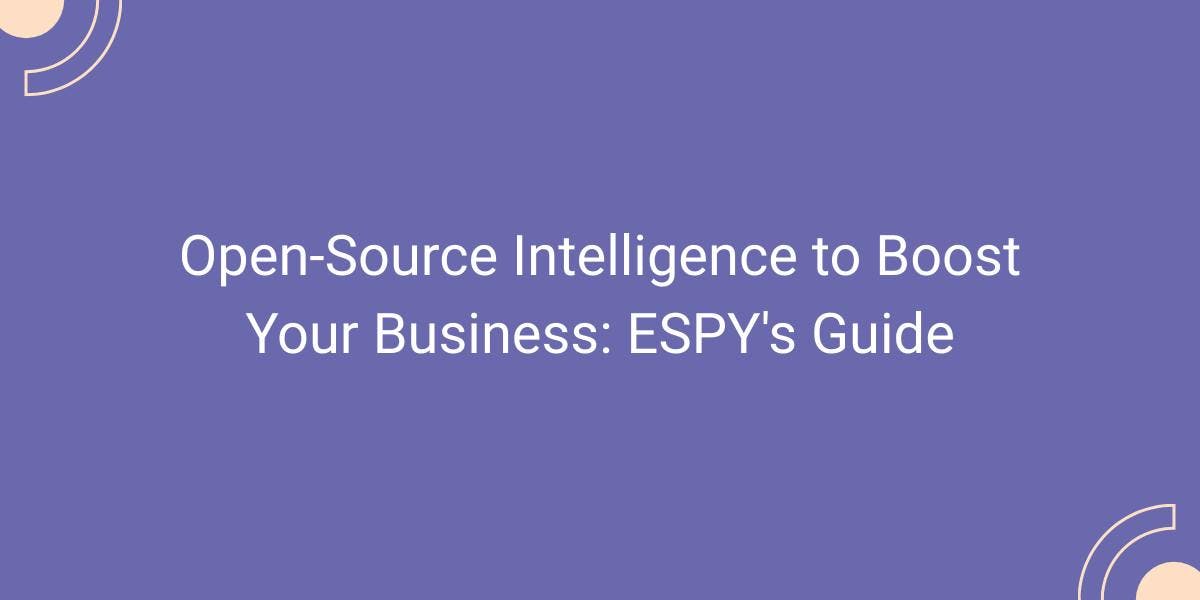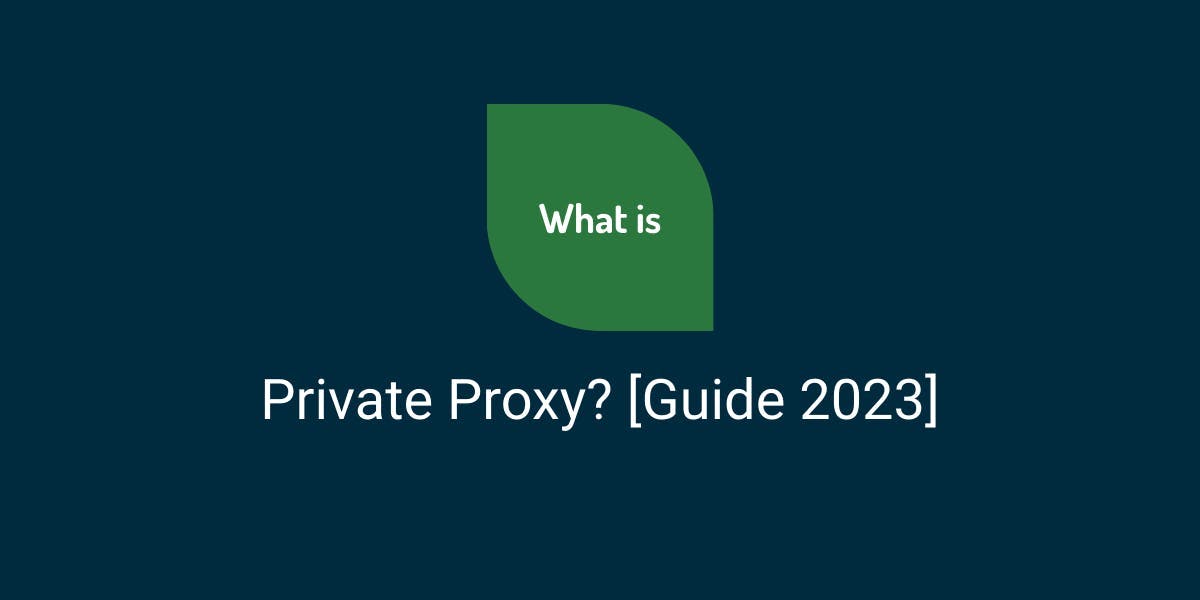Open-Source Intelligence to Boost Your Business: ESPY's Guide
Flipnode on Jun 21 2023

Open-source intelligence (OSINT) is a powerful method for gaining insights into your business landscape. It provides valuable information about your industry, customers, and competitors. However, effectively implementing OSINT requires careful attention and effort.
ESPY, a renowned global expert in OSINT investigation solutions, offers a comprehensive step-by-step guide to help you begin utilizing OSINT tools. Let's delve right into it and explore the world of OSINT.
Set your business goals
Recognizing the significance of this step is crucial, as it forms the foundation of your project and sets the course for subsequent actions. By thoroughly considering your specific business requirements, you gain a clearer understanding of your overall business trajectory. When it comes to OSINT, it is essential to determine the type of data you need and the purposes it will serve. Here are a few examples:
- Competitive intelligence: Monitoring your competitors enables you to tailor your strategies, identify emerging market trends, and seize new opportunities. Additionally, competitor data can be leveraged to enhance your products and services.
- Risk assessment: Open-source intelligence aids in monitoring and identifying potential threats and vulnerabilities. By scanning the web for brand mentions, you can proactively prevent reputation crises and safeguard your brand's reputation.
- Market research: Utilizing OSINT in market research allows for a better understanding of your target market, identification of opportunities and recent market developments, and gaining insight into public opinion towards your brand.
Pick the right OSINT tools
To cater to your specific business goals and requirements, you may consider utilizing the following OSINT tools:
- Web monitoring tools: These tools enable you to actively scan the web, identifying potential threats and monitoring brand mentions across various online platforms.
- Web scraping tools: With the assistance of scraping software, you can extract publicly available data from e-commerce websites, search engines, and other web platforms, facilitating comprehensive information gathering.
- Data analysis tools: Once the data is collected, data analysis tools play a crucial role in processing and analyzing the gathered information, aiding in drawing meaningful conclusions and insights.
Come up with a strategy
Once you have outlined your objectives for gathering data and identified the appropriate OSINT tools, the next step is to formulate a strategic plan. This entails several key components, including:
- Data source selection: Determine the specific data sources you intend to monitor and collect information from. This could encompass various online platforms, social media channels, industry forums, news websites, and more.
- Data security infrastructure: Establish robust measures and protocols to ensure the security and integrity of the collected data. Implement encryption, access controls, and other security mechanisms to safeguard sensitive information.
- Management processes: Define efficient management processes to streamline the data-gathering operation. This may involve creating workflows, establishing data validation procedures, and implementing quality control measures.
- Task delegation and responsibility assignment: Assign specific tasks and responsibilities to team members involved in the OSINT process. Clearly define roles, set deadlines, and foster effective communication channels to facilitate seamless collaboration.
By developing a well-thought-out strategy encompassing these aspects, you can enhance the effectiveness and efficiency of your OSINT data-gathering initiatives.
Train your personnel
To harness the full potential of OSINT tools, it is crucial to provide proper training to your personnel in data analysis, web scraping, and other relevant skills. By equipping your team with the necessary expertise, you can optimize your utilization of open-source intelligence. Here are a few key considerations:
- Data analysis training: Offer training programs that focus on data analysis techniques, tools, and methodologies. This will enable your team members to effectively interpret and draw insights from the gathered data, facilitating informed decision-making.
- Web scraping skills development: Provide training sessions or workshops specifically tailored to web scraping techniques. Equip your team with the knowledge and tools required to extract data efficiently and accurately from various online sources.
- Continuous learning and updates: Encourage your personnel to stay up-to-date with the latest advancements in OSINT and related fields. Promote a culture of continuous learning by providing resources, organizing knowledge-sharing sessions, and encouraging participation in relevant conferences or workshops.
- Collaborative learning environment: Foster a collaborative environment where team members can share their knowledge, experiences, and best practices. Encourage cross-functional collaboration and the exchange of ideas to enhance the collective expertise of your team.
By investing in training and skill development, you can empower your personnel to effectively leverage OSINT tools, maximizing the value and insights gained from open-source intelligence for your organization's benefit.
Asses your results
Finally, it is essential to establish metrics and processes to evaluate the success of your OSINT implementation. By tracking performance and measuring key indicators, you can gain valuable insights into the effectiveness of your strategies and identify areas for improvement. Here are some key considerations for measuring OSINT success:
- Define relevant metrics: Identify the metrics that align with your OSINT goals and objectives. These metrics could include the number of actionable insights generated, the accuracy and reliability of the gathered data, the speed of data acquisition, or the impact on decision-making processes. Choose metrics that provide meaningful insights into the value and impact of your OSINT efforts.
- Establish measurement processes: Develop a systematic approach for collecting and analyzing data related to the identified metrics. Define the frequency of data collection, the responsible individuals or teams for data analysis, and the tools or systems used to track and monitor the metrics. Ensure that the measurement processes are consistent and reliable to provide accurate assessments of your OSINT implementation.
- Regular evaluation and analysis: Periodically review and analyze the collected data to assess the performance and effectiveness of your OSINT efforts. Compare the actual results against the defined metrics and objectives to identify any gaps or areas for improvement. Use the insights gained to refine your strategies, adjust processes, and enhance the overall implementation of OSINT within your organization.
- Continuous improvement: Embrace a culture of continuous improvement by actively seeking feedback from stakeholders, including your team members and decision-makers. Regularly review the measurement processes and metrics to ensure they remain relevant and aligned with your evolving business needs. Continuously refine and optimize your OSINT implementation based on the feedback and insights gained.
By implementing a robust measurement framework and continuously evaluating your OSINT implementation, you can monitor progress, identify successes, and make data-driven improvements, ultimately enhancing the effectiveness and value of your open-source intelligence initiatives.
Wrapping up
Open-source intelligence serves as a treasure trove for businesses aiming to extract valuable insights from publicly accessible web data. By harnessing this vast resource, organizations can construct a comprehensive understanding of the market and make informed, data-driven decisions.



